The splendid banyan trees I met today in a park in Honolulu, Hawaii prompted me to share some things I learned while researching my new book [US edition / UK edition / India] about how fig trees have shaped our world, influenced culture and can help us protect life on Earth.
Here are ten nuggets:
- The banyan (Ficus benghalensis) is one of more than 750 species of fig trees, each of which is pollinated only by its own species of tiny wasps that breed only inside the figs of their partner trees.
- Banyans are strangler figs. They grow from seeds that land on other trees. The roots they send down smother their hosts and grow into stout, branch-supporting pillars that resemble new tree trunks.
- Banyans are the world’s biggest trees in terms of the area they cover. The biggest one alive today is in the Indian state of Andhra Pradesh. It covers 1.9 hectares (4.7 acres) and can shelter 20,000 people.
- Banyans are ecological linchpins. They produce vast crops of figs that sustain many species of birds, fruit bats, primates and other creatures, which in turn disperse the seeds of hundreds of other plant species.
- The first Europeans to encounter banyan trees were Alexander the Great and his army, who reached India in 326 BCE. The notes they took back to Greece informed Theophrastus, the founder of modern botany, and — ultimately — led 17th-century English poet John Milton to write in Paradise Lost that Adam and Eve made the first clothes from banyan leaves.
- Hindus say a banyan tree at Jyotisar is the one Krishna stood beneath when he delivered the sermon of the Bhagavad Gita.
- For thousands of years, people have used banyans as sources of medicines. Today in Nepal, people use banyan leaves, bark and roots to treat more than twenty disorders.
- Hindu texts written more than 2500 years ago describe a cosmic ‘world tree’, a banyan growing upside-down with its roots in the heavens. Its trunk and branches extend to Earth to bring blessings to humanity.
- During India’s struggle for independence from Britain, the British hanged hundreds of rebels to their deaths from banyan trees. Independent India made the banyan its national tree.
- Hawaii’s banyans are not native. People who have planted them there include Franklin D. Roosevelt, Richard Nixon, Amelia Earhart and Louis Armstrong.
Across the world, the banyans and many other fig species have embedded themselves in diverse human cultures, thanks to some amazing biology and an 80-million-year-old relationship with their pollinating wasps. As my book shows, these trees influenced the development of our species and can enrich our future too, by helping us to restore damaged rainforests and protect threatened wildlife. The book was published in the UK as Ladders to Heaven, and in the US and Canada as Gods, Wasps and Stranglers.
Readers in India can buy it here.
I’ll be writing a narrative article about banyans soon (update: here it is). Meanwhile, I will leave you with some more photos of the banyans I saw this morning. Aloha!
Related blog posts:
The stranglers that save lives when cyclones strike
Can living fig-tree bridges save lives in a changing climate?
Where falling fig trees portend political change
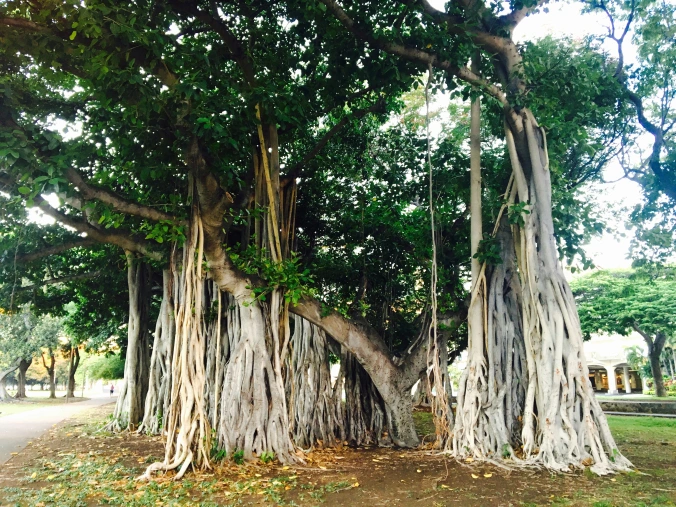
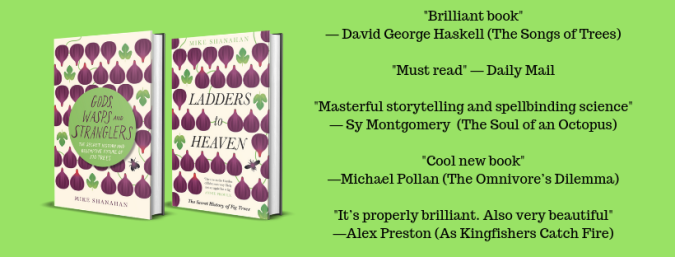
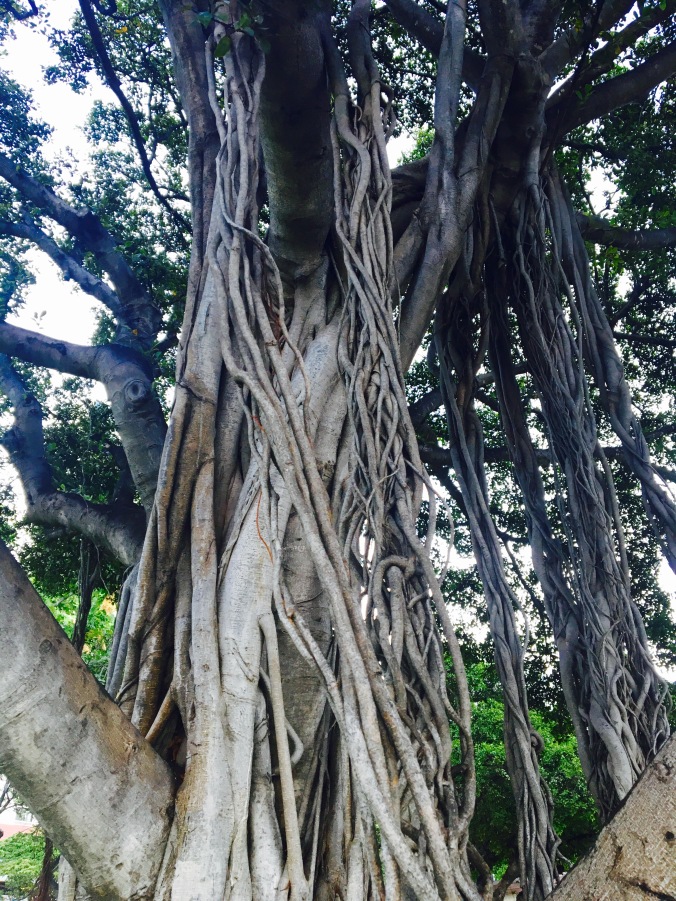
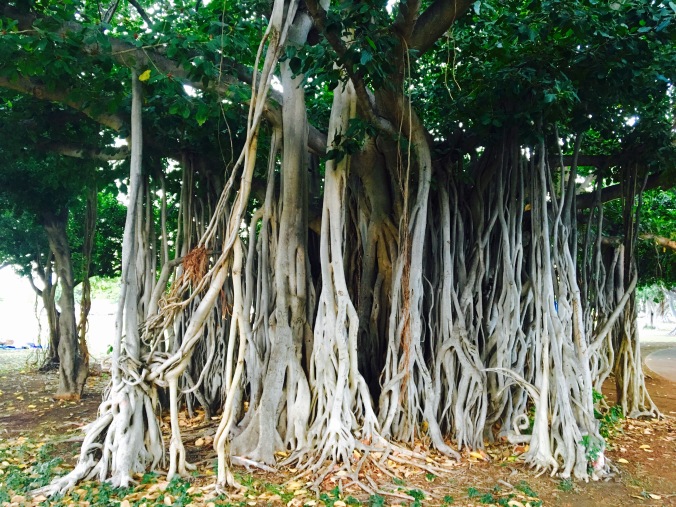
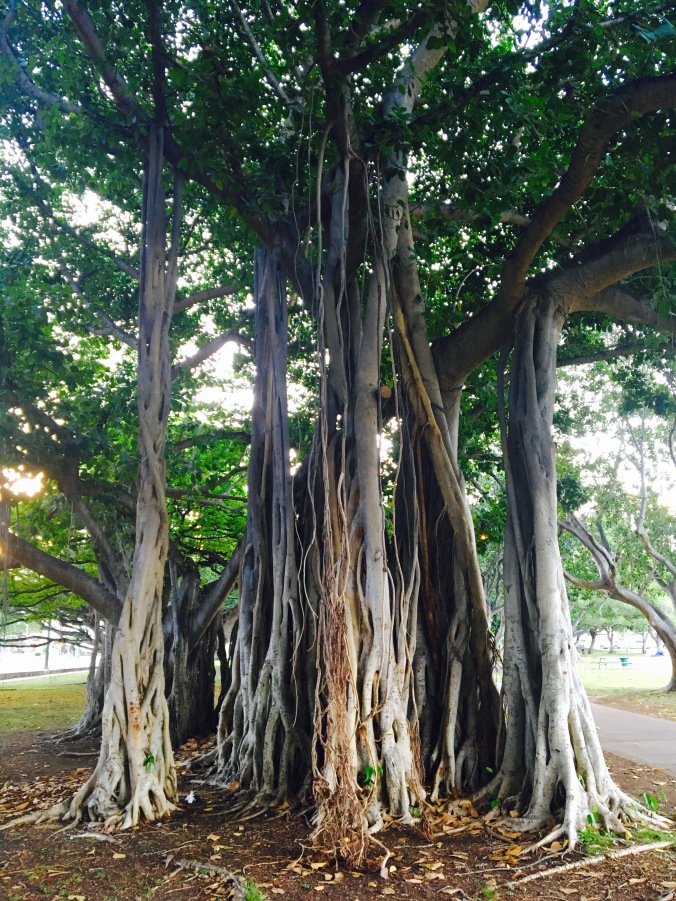
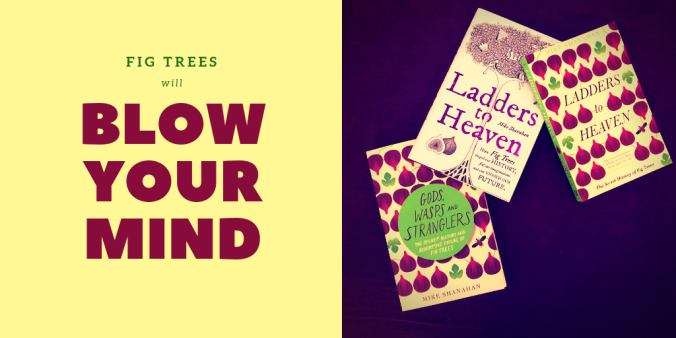
I saw my first BANYAN TREE several years ago in SEGUIN,GUADALUPE CO. TEXAS. I thought it was the most beautiful tree I have ever seen. It is in a very large yard beside someones home. I took some pictures, just made me want a tree like it .How many years does it take for it to get to the point of the limbs to start spreading out?
Hi Sheila. The banyans grow quickly if the climate, etc., are right. The tree’s branches start producing aerial roots very soon
I recently saw a video of a man in Indonesia who plants banyan trees to end drought because they somehow activate water supply? If you are familiar with this, can you explain how, and if it would work in drought stricken areas around the world. Sounds too good to be true, and yet…
Thanks
Hi Stephanie
Thanks for reading and commenting. Planting fig trees can help people deal with drought in a couple of ways. First, by making drought less likely (as in your example) and second by making drought tolerable. In drought-prone parts of Ethiopia for example, researchers have shown that planting fig trees of a species called Ficus thonningii can really help farmers. The fig trees are drought tolerant, so they don’t need to be watered. Their roots seek out water deep underground. The farmers gain by being able to plant crops such as coffee in the shade of the fig trees. The fig leaves provide free fodder for goats. Indeed, the goats that eat the fig-leaf fodder put on more weight than those fed commercial feed. 20,000 households have now planted these trees to help them survive in drought conditions. I wrote about this and other powers of fig trees here: https://blogs.scientificamerican.com/guest-blog/the-nearly-magical-properties-of-fig-trees/
Best wishes
Mike
and what wonderful Temples” they make…when One wants to pray in the Outdoors!…
Yes, in fact they have served as temples long ago
I was always fascinated by the Banyan Tree and saw a 400 year old species in Bangalore, India when I visited there in June of last year. It was breathtaking. I couldn’t stop taking pictures of it and there were monkeys everywhere. What a spiritual experience just walking around it. I plan to make a painting of that Banyan tree. It has a fascinating history.
Banyans really do seize the imagination. I hope you do get to paint one Mignyetta. Here’s another post I wrote about banyans in India https://underthebanyan.wordpress.com/2016/09/23/the-majesty-and-mystery-of-indias-sacred-banyan-trees/
Well
Yes I also feel same as you ones
Mike,
I just returned from Hawaii & I have one seed pod from Maui –plus many photos of the huge banyon tree in Maui! I live in Ma. so I don’t believe I’d be able to grow one here. BUT I’ll soon travel to TN. Will the pod survive for few weeks like it is?
Hi Anita. If you have a fig from a banyan you can open it up and take the seeds out, then wash the seeds clean then dry them before planting. If you leave them in the fig for a few weeks they will probably rot.
Hi Mike! Good to see you and your comments about Banyan trees,I love and work voluntarily for environment protection.For this I have a formal registered NGO “FRIENDS OF ENVIRONMENT” as well in Pakistan.
Keeping in view marvelous benefits of Banyan trees, I have planned to promote and grow Banyan Trees initially in Islamabad and than I want to spread them in other cities of Pakistan.However some people say that these trees suck lot of water from ground and create problems for rest of plants etc.Just let me know,if this is true or not.In future I want to promote Banyan trees in Pakistan.let me know,how may I establish a nursery of Banyan Trees,as these trees are disappearing from Pakistan.
You may also visit http://www.facebook.com/friendofenvironment for more details about our environment related activities.
Hi Muhammad. Thanks for writing. I think the benefits of banyans (providing shade for people and resources for wildlife) outweigh concerns about their water requirements. One issue with banyans in urban areas, however, is that they grow very large over time, so can be a problem for nearby buildings / roads.
Thanks a lot for your reply.I do agree with you ,however just for he sake of knowledge,just confirm if Banyans are water hungry trees or not?If not share some technical reference so that I may defend the same on various forums.
Rest I am already working to promote Banyans.
Thanks
Hi Muhammad. I don’t know of any research on the water use by banyans versus other tree species. Have you seen published research that shows them to be particularly thirsty?
So I see that nobody mentioned the obvious ‘conflict’ between eastern and western philosophy aka religion, that sitting under a Bodhi tree might suggest … ?
Bodhi = Banyan = ‘fig tree’
Gautama Buddha attained enlightenment (bodhi) while meditating underneath a Ficus religiosa. According to Buddhist texts, the Buddha meditated without moving from his seat for seven weeks (49 days) under this tree. … The spot was used as a shrine even in the lifetime of the Buddha …
So goes the narrative … another narrative involves a miracle, a curse, and a fig tree.
Did Jesus sit under a tree or did he in fact ‘curse’ the ‘fig tree’?
https://en.wikipedia.org/wiki/Cursing_the_fig_tree
Dear Raphael, Jesus did not curse The fig tree. He cursed A fig tree (meaning one). It was a (one) fig tree that didn’t produce fruit. So please read, and don’t take the bible out of context.
Thank You.
any medical benifits are available from this tree jayashankar
Yes, there are many uses of its bark, sap and roots in traditional medicine.
Hi! I have a large banyan in my yard and was told it is more than 100 years old. This is a rarity in the metropolitan area I live in! I’ve lived here for over 2 years but only noticed this year that it bears small fruits. Do you know how often and for how long they bear fruit?
Hi Arianna. Banyans can produce little figs more than once a year (depending on their size, age, the climate, etc.). Where in the world are you? If the trees pollinator wasps are also present, those figs should ripen and bear seeds. If not, they will drop off the tree unripe.
Hi Mike,
Thanks for sharing your information. I have always enjoyed the banyan tree and two years ago I planted nearly 70 trees. Now, I am also interested in planting other ficus trees that produce more fruit. If they are similar strangler type I would also like to try using the same trees to be part of a living fence. Do you have any suggestions? I live in a Yucatan Peninsula coastal limestone area that doesn’t have much soil (very similar to the Florida Keys). Lastly, very interesting how you described a scenario where goats were fed ficus fodder. Do you have any information on this? Do you know which ficus can be best used for fodder and in what percentage it can be feed? Any information or direction would be much appreciated.
Thank you
Jim
Hi Jim, thanks for writing. Some of fig species native to Mexico include Ficus aurea, Ficus americana and Ficus maxima. You can download a field guide to Mexican figs here. Fig trees are great as living fences (have you seen how people in India use them to make living bridges?)
Many different fig species have been used as sources of fodder in different places, but some of the best results have been reported in Ethiopia with Ficus thonningii. Research by Mulubrhan Balehegn and colleagues at Mekelle University shows that planting this species instead of the usual fodder crops can boost production by 500 percent, while reducing inputs of water by 95 percent. Goats that eat the fig tree’s leaves produce more and better quality meat than those given only commercial feed (see links here for more information).
I hope this is useful.
Best wishes, Mike.
Thank you Mike!
After researching your response I will likely have a couple of follow up questions.
Hi Mike,
Interesting information about Banyan trees. I enjoyed reading it so much that I have provided a link to this article on a post I made on my blog :- https://kittysverses.wordpress.com/2019/07/24/keep-going/
Thanks a lot for information.
Hi Mike,
I purchased your book “Ladders To Heaven” today and I am eager to start reading it. I also read a couple of your blogs; this one on figs and the one on Jaguars. I liked them and found them worth sharing. That is where the problem started. For some reason, your blog has been banned by Facebook. Links to your blog (any page) is being blocked by facebook. Do you have any clue? Thanks.
Regards,
Soumya
Hi Soumya. First, thanks for buying my book. I hope you enjoy it. I’m not sure what the problem with Facebook is, but I have contacted them and hope they have fix it soon.
Best wishes
Mike
Should we plant banyan tree at home?
Are the thick heavy branches of a banyan tree endangered if their hanging roots are not allowed to take root in the ground?
If the heavy branches are not supported by pillar roots they can eventually bend towards the earth under their own weight. If this happens the branches can then take root in the soil.
Hi Mike, Recently I got a forward from a friend in whatsapp which stated below – Wanted to understand the legitimacy of the message… is it true that banyan tree needs a crow to sprout the seeds? Is it true that banyan tree gives oxygen 24*7?
” Feeding Crows during Mahalaya/Pitru Paksha (a day before Navaratri starts in India)
Why do we feed crows as offerings to our ancestors? Why do we use this lowly bird as a medium to feed our ancestors?
The crow is not a lowly bird for the following reasons:
1. Crows wake up at Brahma Mahurat everydays. (A hen and cock may miss a morning, but a crow never misses it).
2. If a crow finds food, it immediately caws and calls other crows to share (no other animal or bird has this sterling trait)
3. Crows don’t eat after sunset, the shastras too advise against eating after sunset.
All three qualities are something that our ancestors would advise us. Hence they are said to use the crow as the medium and not any other being.
But why feed them during Mahalaya ? This is the only season crows mate and breed. So what? Our civilization wanted crows to breed and multiply. But why? To have more Peepal and Banyan trees around us. What do crows have to do with Peepal and Banyan trees? Peepal and Banyan trees sprout only and only from the seeds that have passed through the intestinal tract of crows, and not from anything else. But why this interest to have more Peepal and Banyan trees? Unlike other trees, Peepal and Banyan trees give out oxygen 24 X 7. They are oxygen plants!
So the next time, someone calls this a superstitious practice, educate the person with this knowledge. “
Hi Pushpa
Many species of birds and mammals can disperse the seed of banyan and peepal trees —not only crow. These trees do not have special oxygen-producing qualities either.
its been said by elders or a common belief that God resides in each tree.
Interesting information about Banyan trees. This is the first time I heard of it.
Isn’t Pando the biggest tree in the world?
Pando is the biggest living thing on the planet but it is clonal organism, made up of many genetically identical trees growing up from the same root system.
I loved how you weaved in not just the scientific aspects but also the cultural and ecological significance of banyan trees. Your personal anecdotes and experiences added a special touch, making this article feel like a friendly conversation.
Thanks James. I wrote a longer post about banyans here: https://underthebanyan.blog/2016/09/23/the-majesty-and-mystery-of-indias-sacred-banyan-trees/ It is an extract from my book (see: https://underthebanyan.blog/my-book/)